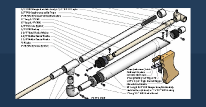
Unprimed.

Push forward to prime. The plunger head is held steady by the front coupler, and so the catch/spring rest push forward to compress the spring. Once all the way forward, the trigger engages. The draw length is 6.5".

Since the trigger is catching the plunger rod, you can pull back the entier plunger rod/head assembly. Once back in the orignal position, you are ready to fire.

Internals overview. You can't use a standard SNAP catch on this. I used a suicide trigger, but this could also be done with a minaturized rainbow catch, or a ring catch. 1" PVC is annoying to work with, since there are no PVC fittings which fit well. I ended up cutting up a piece of 1/2" PVC so that I could widen it enough for 1/2" CPVC to slide easily through it, and then just wrapped it with duct tape. It is held steady in the 1" PVC via a couple of set screws (which do triple duty - they fasten the handle and trigger as well). Let me know if you have any questions.

The catch is a type of suicide trigger, to which I added a ring of metal for reinforcement. A 1/2" wooden dowel connects the rear catch section to the plunger head. I have mixed feelings about these. It catches well enough, but only if your nail is precisely the correct length. They also push the trigger into the "open" position when they aren't primed. Probably better to use a different type of catch for this sort of application.

The trigger and handle might be of some interest. I moved the clothespin back into the handle housing, and flipped the orientation of the L bracket. It ends up being about half the length of a regular SNAP trigger and handle (take a look at the comparison shot below this picture). My implementation is a clusterfuck, but the general layout works fine.

Here it is next to Quixote, which is 32" long. The push-action SNAP is 26" long, and there is some room to be saved in the rear of the blaster.

Edited by Daniel Beaver, 25 November 2011 - 08:11 PM.


























